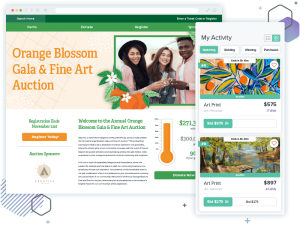
Erica Linguanti passionately believes that the emergence of social media has created an opportunity for organizations to innovate and engage with donors in entirely new ways. As the Director of Marketing at Achieve, Erica leads the strategy and execution of all marketing initiatives, with an emphasis on helping nonprofits tell their stories digitally. By combining the unique needs of nonprofits with experience from working closely with major “for profit” brands—including Hilton, Marriott, Preferred, and IHG—she has developed unique tactics to drive interest for causes (and convert that interest into action). Erica holds a BSBA in Marketing from the University of Central Florida.
With Giving Tuesday just around the corner, hopefully you’ve crossed all of your campaign t’s and dotted your i’s (If not, don’t panic. You can always leverage free Giving Tuesday Toolkits like this one to help finalize your plans.).
What started out as a social holiday to remedy the commercial shopping of Black Friday and Cyber Monday, Giving Tuesday has now turned into a day of philanthropy marked by billions of dollars in online charitable giving. Yes, you read that correctly—BILLIONS! In fact, last year in the United States, almost $2 billion was raised in just 24 hours on Giving Tuesday.
With only a short window of time until the big day, check out these last-minute actions you can take to help reach your Giving Tuesday goals:
1. Make sure your website is set up for fundraising success.
Did you know that opinions about your website are formed in just 50 milliseconds?!
If your nonprofit website could use some love, try out some of the tips below or snag free access to this webinar recording full of simple DIY tricks to improve your website design.
- Make it easy to give. Don’t make your supporters struggle to figure out what actions you want them to take. Is your donate button clear and prominent like this United Way of Broward County example? Does your landing page have a clear call-to-action? Is your donation form simple and easy to fill out? Help your donors by taking out the guesswork.
- Trim the excess fat. With 55% of people spending less than 15 seconds on a web page, it’s important that your website is easy to scan. Don’t make it difficult for your supporters to understand your messaging! Try using large descriptive headings along with photos, videos, and/or graphics to quickly communicate information—and remember to keep your copy short and sweet (linking out to other pages with additional descriptions as needed).
- Speed up your load time. Does it take longer than 3 seconds for your nonprofit website to load? If so, you’re missing out on approximately 53% of all mobile site visits according to Google! Check your web speed with free tools like Google’s PageSpeed Insights. If it looks like images are slowing down your site, try optimizing them for free with an online image optimizer like this one.
- Don’t forget about trackability. It’s hard to know which fundraising tactics are working for your organization if you can’t track where your donations are coming from! Make sure you’ve installed a Facebook Pixel onto your website and implemented Google Analytics. Then, take it a step further by using tracking links with tools like URL Campaign Campaign Builder[SL1] and/or Bitly.
2. Ensure your messaging is personal.
With a giving day, there naturally comes a lot of competition. By tailoring your messaging specifically to your audience, you can help cut through the chatter.
- Put on your donor hat. Why should your donors care? What’s in it for them?! As a nonprofit marketer, I sometimes like to look outside the industry for inspiration. This “anti-ad” by Doritos does a great job of making the commercial about “you” (the consumer) by removing all brand logos and highlighting your personal experience eating their crunchy, flavorful chips. Even though ultimately the “anti-ad” is in fact an advertisement for Doritos (and a memorable one at that), it succeeds because they shifted the spotlight away from the brand and instead focused on the user experience. When finalizing your Giving Tuesday fundraising messaging, I encourage you to “think Doritos.”
- Make it tangible. If you’re hoping to raise a specific dollar amount, try to make the impact tangible instead of just a number. For example, asking donors to “help 30 more kids succeed in school this year” is probably going to be more compelling than simply stating that your goal is to raise $30,000.
People typically give because they recognize there’s a problem, they believe your organization is working toward a solution to that problem, and most importantly, they feel that by supporting your organization they’re a part of that solution. Your messaging should reflect this motivation.
3. Take advantage of social media fundraising tools.
Undoubtedly, many nonprofits will be relying heavily on social media to help propel their Giving Tuesday campaigns. By expanding your social media fundraising toolkit, you open up more opportunities to make it even easier for your donors to give!
- Facebook Donation Account. If you don’t have a Facebook Donation Account in 2020, what are you waiting for?! With zero processing fees and an easy in-app experience, setting up a Facebook Donation Account should be a no-brainer. If you still haven’t set up your account, visit facebook.com/donate/signup and create a payout account with your organization’s banking information.
- Instagram Fundraising Tools. Assuming you already have a Facebook Donation Account, you can take advantage of the fundraising tools on Instagram by adding a donate button to your profile, using donation stickers in Stories, and fundraising via Live Stream. If you need help getting started, check out these step-by-step instructions.
- TikTok Fundraising. If your organization is ahead of the curve with an active TikTok account, you’re in luck! TikTok recently rolled out public profile fundraisers in addition to fundraising stickers (introduced back in April). This opens up some great peer-to-peer fundraising opportunities.
As a word of caution—while social media fundraising tools can be very impactful, they’re not a magic bullet. According to the 2019 M+R Benchmark Study, for every $100 raised directly through a nonprofit website, on average only $1.77 is raised through Facebook fundraising tools. Further, the average Facebook fundraiser gift is a modest $31 with the bulk of these donations coming from peer-to-peer fundraisers (often birthday fundraisers).
There are certainly tons of nonprofits that absolutely crush it with social media fundraising tools (I’m looking at you charity: water), but if you’re new to using these types of tools don’t be surprised if it’s harder than you think to build momentum.
I tend to look at social media fundraising tools as the whip cream and cherry on top of a sundae. It’s not required, but it certainly doesn’t hurt to sweeten the deal!
4. Recruit your crew.
Never underestimate the power of a share! Now is the time to rally your team and get your group of social ambassadors together to help amplify your message.
Typically, most organizations will only ever organically reach 1-4% of their Facebook followers. For better or worse, Facebook (and Instagram) have become very much pay-to-play landscapes. To help your messaging be seen without relying on paid spend, you’ll need lots of organic engagement to open up the algorithm and make sure your message is seen.
- Ask your team. Can your team, board, or volunteers share posts about your campaign? Would they be willing to create individual Facebook fundraisers on your behalf? Would your sponsors and community partners be willing to share tagged content? It may help to create a media kit for your team to make it easier for them to execute your ask.
- Ask your supporters. Try including a call-to-action in your donation thank-you email or thank-you page that asks donors to share a #GivingTuesday campaign post on social media after they’ve donated. Not only can this help them feel good about their contribution, it can indirectly inspire their network to donate as well.
Final Thoughts
My final thought to you, dear nonprofit fundraiser, is: go to the mattresses.
As Joe Fox (Tom Hanks) tells the beloved Kathleen Kelly (Meg Ryan) in the 1998 romcom You’ve Got Mail, “You’ve got to go to mattresses.” Fight for your organization. Get creative. Send out those press releases. Rally the local news and radio stations. Secure a match if you can. Collaborate with local businesses and partners. Test and learn new ideas. Review your #GivingTuesday Checklist.
If you share your story effectively to the right audience, your donors will easily see that your organization is unique and worthy of support. Happy fundraising!



